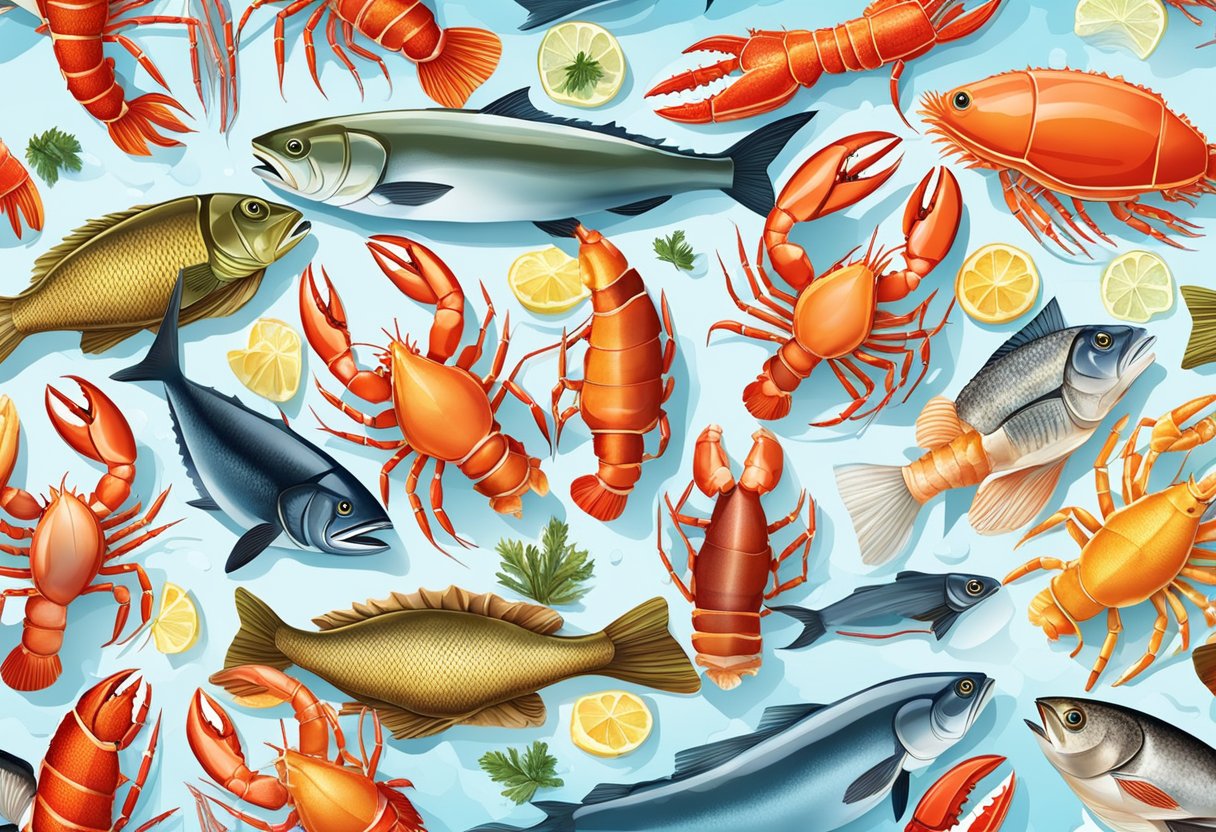Types Of Seafood
Seafood is a popular food choice worldwide. It is a rich source of protein, omega-3 fatty acids, and other essential nutrients. Seafood is also known for its unique taste and texture, making it a favorite among food enthusiasts.
There are various types of seafood available in the market, including fish, shellfish, and crustaceans. Each type of seafood has its own unique taste, texture, and nutritional value. Some of the most popular types of seafood include salmon, shrimp, crab, lobster, oysters, and mussels. These seafood varieties are not only delicious but also offer numerous health benefits.
In this article, we will explore the major types of seafood, their culinary techniques, nutritional benefits and concerns, seafood in global cuisine, and sustainability and environmental impact. We will provide you with valuable information that will help you make informed decisions about incorporating seafood into your diet.
Key Takeaways
- Seafood is a rich source of protein, omega-3 fatty acids, and other essential nutrients.
- There are various types of seafood available in the market, including fish, shellfish, and crustaceans.
- In this article, we will explore the major types of seafood, their culinary techniques, nutritional benefits and concerns, seafood in global cuisine, and sustainability and environmental impact.
Major Types of Seafood

Seafood is a popular and healthy food choice for many people around the world. It includes a wide range of edible aquatic animals and plants, such as fish, shellfish, mollusks, crustaceans, and echinoderms. In this section, we will discuss the major types of seafood, their characteristics, and how they are commonly prepared.
Finfish
Finfish are a type of seafood that includes any fish with fins and gills. They are a good source of protein, omega-3 fatty acids, and other essential nutrients. Some of the most popular types of finfish include:
- Cod: A mild-flavored fish that is often used in fish and chips.
- Sardine: A small, oily fish that is packed with omega-3 fatty acids.
- Tuna: A large, meaty fish that is often used in sushi and salads.
- Salmon: A fatty fish that is rich in omega-3 fatty acids and is commonly grilled or baked.
- Eel: A long, thin fish that is often grilled or smoked.
- Mackerel: A flavorful fish that is commonly smoked or grilled.
- Trout: A freshwater fish that is often pan-fried or grilled.
- Sea bass: A white, flaky fish that is often baked or grilled.
- Halibut: A large, meaty fish that is commonly grilled or baked.
- Catfish: A freshwater fish that is often fried or grilled.
- Herring: A small, oily fish that is often pickled or smoked.
- Shark: A meaty fish that is often grilled or baked.
- Anchovies: A small, salty fish that is commonly used as a pizza topping.
- Swordfish: A large, meaty fish that is often grilled or baked.
- Bass: A white, flaky fish that is often baked or grilled.
- Flounder: A flatfish that is often pan-fried or baked.
- Perch: A freshwater fish that is often fried or grilled.
- Sturgeon: A large, meaty fish that is commonly used to make caviar.
- Rainbow trout: A freshwater fish that is often pan-fried or grilled.
- Bluefin tuna: A large, fatty fish that is often used in sushi.
Shellfish
Shellfish are a type of seafood that includes any aquatic animal with a shell. They are a good source of protein, vitamins, and minerals. Some of the most popular types of shellfish include:
- Crab: A crustacean that is often boiled or steamed.
- Lobster: A large crustacean that is often boiled or grilled.
- Shrimp: A small crustacean that is often boiled or grilled.
- Octopus: A cephalopod that is often grilled or braised.
- Oyster: A bivalve mollusk that is often eaten raw or cooked.
- Clam: A bivalve mollusk that is often steamed or fried.
- Roe: The eggs of fish or shellfish that are often used in sushi or as a garnish.
- Sea urchin: A spiny echinoderm that is often eaten raw or cooked.
- Squid: A cephalopod that is often fried or grilled.
Mollusks
Mollusks are a type of seafood that includes any soft-bodied animal with a shell. They are a good source of protein, vitamins, and minerals. Some of the most popular types of mollusks include:
- Oysters: A bivalve mollusk that is often eaten raw or cooked.
- Clams: A bivalve mollusk that is often steamed or fried.
- Scallops: A bivalve mollusk that is often pan-seared or grilled.
- Mussels: A bivalve mollusk that is often steamed or boiled.
- Cuttlefish: A cephalopod that is often grilled or fried.
Crustaceans
Crustaceans are a type of seafood that includes any aquatic animal with a hard exoskeleton and jointed legs. They are a good source of protein, vitamins, and minerals. Some of the most popular types of crustaceans include:
- Crab: A crustacean that is often boiled or steamed.
- Lobster: A large crustacean that is often boiled or grilled.
- Shrimp: A small crustacean that is often boiled or grilled.
- Prawns: A larger version of shrimp that is often grilled or fried.
- Crayfish: A freshwater crustacean that is often boiled or fried.
Echinoderms
Echinoderms are a type of seafood that includes any aquatic animal with a spiny exoskeleton. They are a good source of protein, vitamins, and minerals. Some of the most popular types of echinoder
Culinary Techniques
Cooking Methods
Seafood can be cooked in a variety of ways, each method bringing out a unique flavor and texture. Some popular cooking methods for seafood include baking, poaching, steaming, and grilling. Baking is a safe and easy way to cook fish, and it is ideal for thicker and oilier fish as it is less likely to dry out during cooking. Poaching is a gentle cooking technique that results in tender and flavorful seafood. It involves cooking the seafood in a flavorful broth made from water, wine, herbs, and aromatics like garlic and onion. Steaming is another gentle cooking method that preserves the delicate flavor and texture of the seafood. Grilling is a high and quick heat cooking method that is best for a whole fish with skin.
Preservation Methods
Seafood can also be preserved using various methods like smoking, drying, and salting. Smoking seafood is a popular preservation method that adds a unique smoky flavor to the seafood. It involves exposing the seafood to smoke from burning wood chips or sawdust. Drying seafood is another preservation method that involves removing moisture from the seafood, making it last longer. Salted seafood is also a popular preservation method that involves curing the seafood in salt. It adds a salty flavor to the seafood and makes it last longer.
Overall, there are many culinary techniques that can be used to cook and preserve seafood. Each method brings out a unique flavor and texture, and it is up to the individual to choose the method that best suits their taste preferences.
Nutritional Benefits and Concerns
Health Benefits
Seafood is an excellent source of protein and is known for its numerous health benefits. It is low in saturated fat and high in omega-3 fatty acids, which are essential for maintaining good health. Omega-3 fatty acids are beneficial for heart health, reducing inflammation, and improving brain function. Seafood is also rich in iron, which is essential for the production of red blood cells.
In addition to being a good source of protein and omega-3 fatty acids, seafood is also low in calories. For example, a 3-ounce serving of cooked shrimp contains only 84 calories. This makes seafood an excellent choice for those who are watching their weight or trying to maintain a healthy diet.
Dietary Considerations
While seafood is generally considered healthy, there are some dietary considerations to keep in mind. One concern is the risk of mercury contamination. Some types of seafood, such as shark, swordfish, and king mackerel, are known to contain high levels of mercury. Pregnant women, nursing mothers, and young children are advised to avoid these types of seafood or limit their consumption.
Another consideration is the cooking method. Fried seafood is high in calories and can be unhealthy if consumed in large quantities. Grilled, baked, or steamed seafood is generally a healthier option.
Overall, seafood is a nutritious and healthy addition to any diet. It is important to choose a variety of seafood and to cook it in a healthy way to maximize its nutritional benefits.
Seafood in Global Cuisine
Seafood has been an integral part of global cuisine for centuries. From sushi in Japan to ceviche in South America, seafood dishes are enjoyed by people all over the world. In this section, we will explore some of the most popular seafood dishes from different regions of the world.
Asian Seafood Dishes
Asian cuisine is famous for its seafood dishes, which are often characterized by their unique flavors and textures. Sushi, a Japanese delicacy, is perhaps the most well-known Asian seafood dish. It consists of vinegared rice topped with various raw fish or seafood, and is often served with soy sauce, wasabi, and pickled ginger.
Another popular Asian seafood dish is Korean-style grilled squid, which is marinated in a spicy sauce and grilled over charcoal. This dish is often served as a side dish or as a main course.
Western Seafood Dishes
Western cuisine also has a rich tradition of seafood dishes. Paella, a Spanish dish, is a rice-based dish that is often made with seafood, such as shrimp, mussels, and clams. It is seasoned with saffron and other spices, and is often served as a main course.
Bouillabaisse, a French seafood stew, is another popular Western seafood dish. It is made with various types of fish and seafood, and is seasoned with herbs and spices. It is often served with bread and a side of rouille, a garlic and saffron mayonnaise.
Seafood dishes are enjoyed by people all over the world, and are an important part of many different cuisines. Whether you prefer Asian-style sushi or Western-style bouillabaisse, there is a seafood dish out there for everyone to enjoy.
Sustainability and Environmental Impact
As the world’s population continues to grow, the demand for seafood increases, leading to overfishing and the depletion of marine populations. Sustainability is essential to ensure that future generations can continue to enjoy the benefits of seafood. Sustainable seafood is wild-caught or farmed seafood that is harvested or produced in ways that protect the long-term health of species populations and ecosystems.
The environmental impact of seafood consumption is a significant concern. Pollution, global warming, and overfishing have led to the rapid decline of marine populations over the last few decades. It is, therefore, crucial to choose seafood that is sustainably sourced to minimize the environmental impact.
When it comes to sustainability, not all types of seafood are created equal. Some species are more sustainable than others, and it is essential to choose seafood that is responsibly sourced. The following table provides a brief overview of the sustainability of some popular types of seafood:
| Type of Seafood | Sustainability |
|---|---|
| Aquatic Animals | High |
| Freshwater Fish | Moderate |
| Sea Mammals | Low |
| Echinoderms | High |
| Mollusks | High |
It is worth noting that the sustainability of seafood can vary depending on the specific species, the fishing or farming method used, and the location. It is, therefore, essential to do some research before making a purchase.
Consumers can also look for certifications from organizations such as the Marine Stewardship Council (MSC) and the Aquaculture Stewardship Council (ASC). These certifications indicate that the seafood has been responsibly sourced and meets specific environmental and social standards.
In conclusion, sustainability and environmental impact are crucial considerations when it comes to seafood consumption. By choosing sustainably sourced seafood and supporting responsible fishing and farming practices, consumers can help to protect the long-term health of marine populations and ecosystems.






